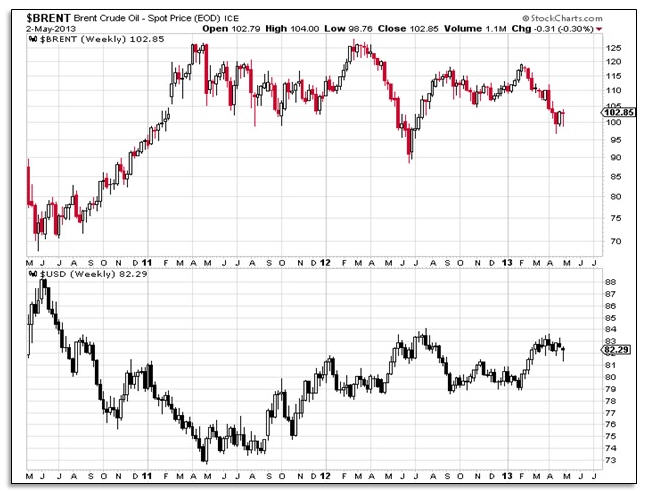Many investors study supply and demand statistics to figure out where they think the oil price is going.
But by far, the biggest factor that determines the oil price is the US dollar, says Donald Dony, who pens The Technical Speculator investment newsletter.
“The US dollar is absolutely pivotal for commodity prices,” he says. To pros in the investment game, that is a truism; obvious. But most investors underestimate the background impact the greenback has on oil prices.
And Dony expects the US dollar to keep grinding higher.
“Our analysis on the USD is looking bullish on the longer term basis—86-87 or even up to 90 cents on USD index. The U.S. economy continues to improve thanks to the ongoing commitment of the Fed to its stimulus program. As long as the Dollar keeps rising, we will definitely see a negative impact on oil prices. The dollar needs to fall through $0.82 before a trend reversal occurs. If it does, commodities should jump.”

He adds that the US dollar and the S&P 500 index appear to be back to their traditional—and positive—connection, that’s not good for commodities.
“I see another six more months of higher S&P. All tops are big distribution pattern. Generally speaking, what happens is that for 6-8 months the market can’t move higher—but it doesn’t drop either.
“If that’s the case, we have nothing like that in the S&P right now. That alone gives us a bit of a picture. If the S&P stays at 1600 all through the summer, we may not see a downturn until the end of the year. These distributions last for months—often 6 months or more, where the market tries to go higher but there just aren’t enough buyers.”
Dony also says the oil price also follows the stock market-but not like it did years ago. He says that now, unlike 30 years ago, we have a real world economy; it’s not just the S&P based in the USA. Oil is following what global markets are doing, not just the S&P—and he says global markets not really going anywhere; they’re up marginally but not strong.
Dony expects the world’s stock markets to continue advancing slowly as long as the U.S. stimulus program is in place.
“The charts show there is a rhythm to GDP (Gross Domestic Product) over the last 30-40 years that gives us a low every five years. If that’s the case, we’ll likely see the next low sometime in 2014. I don’t know how deep or how long the next correction will be. And most of the world’s GDP has already declined for the last two years—even three. I expect another low next year.”